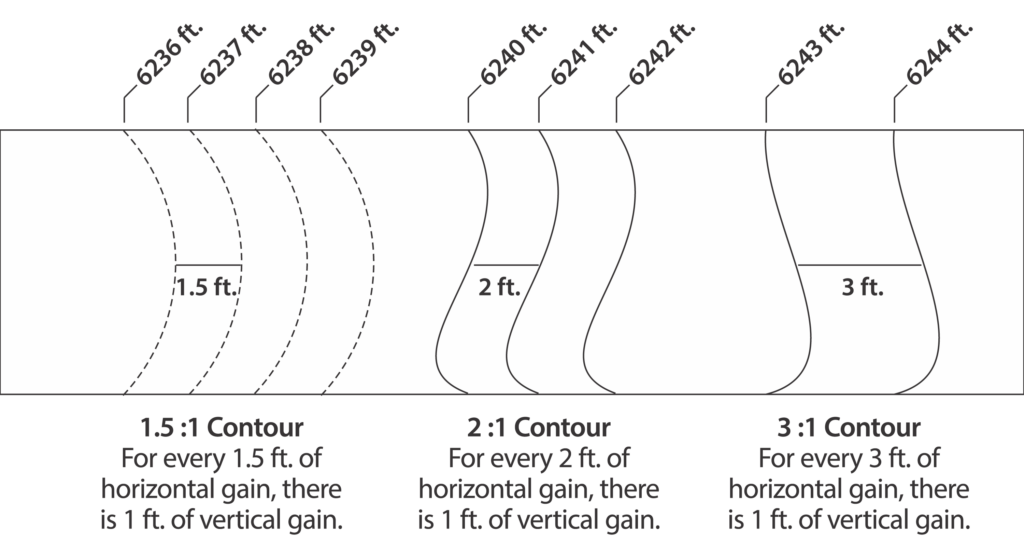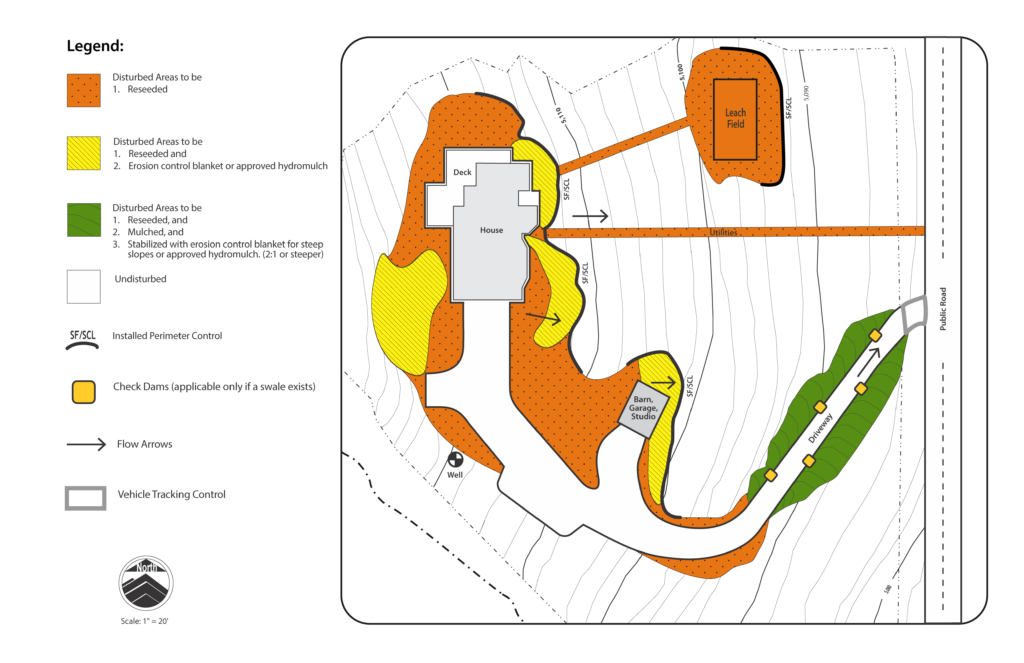Proper revegetation of disturbed areas is an integral part of construction and clean up projects. Successful revegetation is essential to slow soil erosion, repair scarring from cut and fill slopes, minimize sediment transport, and to help deter noxious weeds. This handout is meant to provide common requirements for projects in the county.
The Revegetation Plan
Use a copy of your site plan to delineate the areas you expect to be disturbed by construction. View the example Revegetation Plan. Common disturbances include areas around a house/building, along the driveway or other access drives, utility corridors, septic system, staging/construction stockpiling areas, and parking areas. The locations of perimeter control measures must also be shown on the revegetation plan within the limits of disturbance and remain in place until final stabilization is achieved. Additionally, revegetation plans must indicate the method of stabilization (pavement, gravel, vegetation). For areas that will be revegetated, success will be dependent on several factors listed in this handout including but not limited to topsoil, soil preparation, seed, and mulch or other cover.
Topsoil Salvaging
Topsoil salvaging entails scraping off the existing topsoil or the uppermost, fertile layer of the soil and setting it aside until needed. Topsoil salvaging should not be performed when soil is wet. Topsoil depths generally range from 4” or more in the plains to 1” or less in the mountains. To determine the amount of existing topsoil that is available for salvaging on the project, dig a 6″ hole and look for darker soil that resembles ground coffee beans. This layer is the topsoil layer, and the depth of topsoil is the amount available. Topsoil should be stockpiled from disturbed areas separately from the other soil. After construction is complete and revegetation is started, the topsoil should be spread out to a minimum depth of 3″ or more on all surfaces that are to be seeded as part of the soil preparation. For steeper slopes or where there is not adequate topsoil, a soil amendment should be incorporated into the soil prior to seeding. The addition of fertilizer is usually unnecessary, and it can promote the growth of annual weeds. Topsoil should be mulched and seeded within 24-48 hours of placement
Soil Preparation
Seedbed preparation is crucial to successful revegetation. Slopes should be graded to avoid steep slopes and concentrated flow where feasible. Areas compacted by machinery and equipment during construction should be disked, tilled, or scarified by a tractor or backhoe, to loosen soils allowing for water infiltration and root growth prior to spreading the topsoil. Following the redistribution of topsoil, the area should be tilled again, breaking up clods larger than 3” and harrowed, prior to seeding. Soil preparation should not occur when the soil is frozen or in an extreme wet or dry condition because working the soil in these conditions will cause damage to the soil structure.
Seeding
Seeding can take place from the fall until spring, including the winter months as long as the soil is workable. Many native seeds require a period of cold to germinate and are not harmed by being in the soil over winter. The best time to seed on the plains is September 15 to March 31. At higher elevations, seeding can be done later into the spring and early summer. If seeding is not performed within 14 days of completing a construction or clean-up project, then temporary stabilization such as mulching should be implemented.
Drill seeding is the preferred seeding method, if feasible. If the area is too small or steep for a tractor to operate, broadcasting the seed by hand or with a mechanical spreader and raking in the seed is acceptable. Boulder County does not recommend hydroseeding; it does not work in our arid climate; however, if the slopes are too steep for any other method of seeding, hydroseeding may be approved by the county in limited locations.
Pay close attention to the recommended rates of seed application. Broadcast seed needs to be applied at double the rate of drilled seed. The county encourages adding an annual sterile grass to provide temporary cover for the native seeds while they germinate. See Boulder County Native Seed Mixes for recommended species and seeding rates.
Seed List
In the Revegetation Plan, identify seed mixes and where they are being used.
The county highly encourages the use of native vegetation in the plains. Mountain projects above 5,500 feet are required to use native grasses. Depending on location, some plains projects will also be required to use native grasses. The seed mix must also include application rates.
Mulch
A mulch is necessary to keep the seed and topsoil in place. Mulch also provides shade to the seedlings and helps to retain soil moisture. On slopes of 3:1 or less, the mulch may consist of weed-free straw. State certified weed free straw bales are denoted by twine that is blue and orange. The straw should be applied at 1.5 to 2 tons per acre. This is roughly one standard straw bale per 650 square feet. Do not mulch too thickly; some of the soil should still be visible to allow for solar warming. If a tractor is available, the straw can be “crimped” into the soil with a crimping tool. Crimping orients some of the straw vertically and keeps it in place, minimizing wind erosion. Crimping mulch is required on project that disturb an acre or more or have a Stormwater Quality Permit. Hydromulching is another option for covering the seed. For projects that have coverage under a Stormwater Quality Permit (SWQP), approval by the County Stormwater Inspector is required prior to hydromulching. For small areas that do not have a stormwater quality permit and are located in the mountains, spreading a very light layer of pine needles over raked-in seed is acceptable.
Erosion Control Blanket
Slopes 3:1 (horizontal:vertical) or steeper require erosion control blankets (ECB). Common types of blankets include coir (coconut or jute fiber), straw, aspen fibers, or a blend of these. Steeper slopes will require more durable blankets. Talk to a vender about which product will work for your situation. The county requires biodegradable netting since this type of netting breaks down more quickly and is less of a hazard to wildlife.
Residential lots where the builder is not responsible for landscaping may leave the lot unvegetated under the following conditions:
- Perimeter control measures (e.g. straw wattles, silt fence, compacted berm) must be in place and will be the responsibility of the homeowner to maintain
- Downspouts from roof gutters must be protected with rock or erosion control blanket.
- If the perimeter control measures cannot be left in place, the parcel may be temporarily stabilized (e.g. surface roughening, mulch) with approval from the County Stormwater inspector.
Residential lots where the builder is not responsible for landscaping may leave the lot unvegetated under the following conditions:
- Perimeter control measures (e.g. straw wattles, silt fence, compacted berm) must be in place and will be the responsibility of the homeowner to maintain; and
- Downspouts from roof gutters must be protected with rock or erosion control blanket.
- If the perimeter control measures cannot be left in place, the parcel may be temporarily stabilized (e.g. surface roughening, mulch) with approval from the County Public Works Stormwater inspector.





